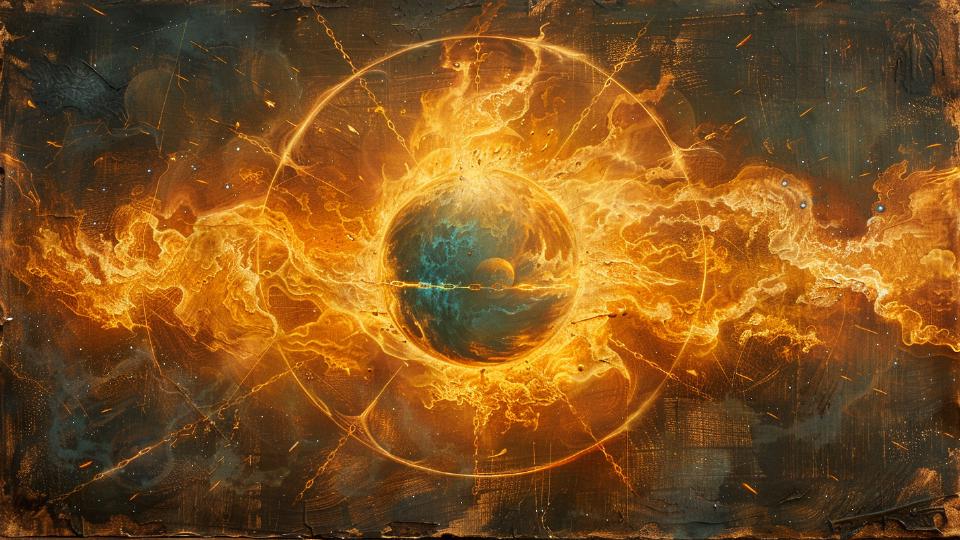
At the solar plexus, practitioners of visionary or contemplative practice frequently report the perception of a luminous sphere. This sphere is encircled by bands or chains, often compared to the rings of Saturn. The imagery suggests not merely containment, but constraint: the sense that an ancient and enduring binding governs this center of being. Within the sphere resides the Daimon, yet the spirit itself is not chained. Rather, the enclosing rings impose the atmosphere of restriction. The impression conveyed is one of necessity and compulsion, whether through cosmic law or through the accumulated effects of malefic influence. The sphere reflects both the inevitability of fate and the possibility of vitality siphoned away, producing a profound sense of limitation.
The imagery resonates with Hermetic teaching, which describes humanity as bound until Nous descends. The chains of the sphere can also be understood in terms of the soul’s descent into generation, where it becomes subject to the compulsion of fate.
The Role of the Solar Plexus
The solar plexus has long been identified as the knot of embodied will, vitality, and the seat of the Daimon. It functions as the natural binding point of heimarmene, the cosmic necessity that orders the realm of generation. As the “engine room” of personal destiny, this center is uniquely vulnerable to both cosmic law and deliberate sorcery. It is here that the machinery of fate intersects with the individual’s power to act, creating a point of tension where constraint and potential converge.
Neoplatonic philosophy describes the embodied soul as woven into the fabric of necessity, its powers divided among the levels of reality. Thus the solar plexus stands as the very organ where necessity and freedom are contested.
The Daimon in the Sphere
When first encountered, the Daimon within this bound sphere often appears grotesque, bestial, or even devilish. Its image is distorted by the chains that surround it, so that its presence is experienced not as a guide but as a jailer or enforcer of compulsion. The Daimon, in its essence the personal spirit, becomes caught in the machinery of necessity and fate. Rather than ministering to the soul’s higher aspirations, it appears as the guardian of limitation, its function bent toward compulsion and enforcement.
Without purification, the personal Daimon manifests in its lower form, binding the soul to the body and to necessity. Only through illumination can it be elevated to its luminous role.
Nous as Liberation Force
Into this condition descends Nous, the intellective fire that is sovereign and unbound. In visionary practice, Nous appears not as a chained or fettered entity, but as the liberating principle itself. United with the purified will, Nous descends as a flame into the plexus. It is not of the order of necessity, but rather the principle that transcends it. As such, Nous acts to unbind both the Daimon and the solar plexus, restoring each to its proper role in the hierarchy of the soul.
Philosophers of the Platonic school affirmed that Nous, when united with the soul, elevates it beyond the chains of fate. Liberation is thus a return to intellect, the higher order of being.
The Act of Unchaining
The decisive act is the driving of flames—Nous in union with will—into the solar plexus. This fiery descent breaks apart the rings that have long constrained the Daimon’s sphere. The result is a release of vitality that has often been bound for decades, with the restoration of currents of energy previously inaccessible. Once liberated, the Daimon no longer appears grotesque or bestial but reveals itself as a free presence within its sphere. The solar plexus, transformed from prison to sanctuary, becomes the site of renewed strength and luminous activity.
The alchemists likened this stage to the dissolution of corrupt forms, a prerequisite for release and renewal. The image of breaking chains and restoring flow reflects the same principle: the separation of spirit from imprisoning matter.
Implications of Release
The release of the Daimon, however, is not the conclusion of the work. Left ungoverned, the Daimon may manifest as volatile or unruly force. The next necessity is the enthronement of Nous at the crown, ensuring its role as ruler of the soul’s order. Under the sovereignty of Nous, the Daimon is not destroyed but converted into a luminous minister. In this role, it ceases to be the jailer of compulsion and becomes instead a willing servant of intellective light. The solar plexus, once bound, is reconfigured as a lamp of the blue flame, radiating vitality aligned with higher principle.
The transformation of the Daimon reflects the doctrine that forces once binding may be transfigured when subordinated to higher rule. The release of such power must be followed by its integration, lest chaos arise in place of order.
Doctrinal Context
This process is supported by multiple strands of tradition. The Hermetic writings affirm that humanity remains bound until Nous descends as liberator. In Neoplatonic philosophy, the personal Daimon may be transformed into its luminous form, but only when subordinated to Nous. The alchemical tradition describes this stage as nigredo, the dissolution and breaking-down of the old bindings in order to prepare the Work. The Orphic tablets remind the initiate that they are a child of Earth and of starry Heaven, pointing toward liberation from the bonds of generation through remembrance of divine origin.
The imagery of chains at the solar plexus captures the interplay of necessity, fate, and liberation. It is a vision of how the Daimon, seat of personal destiny, becomes bound in the machinery of compulsion, and how Nous descends as liberating fire to unbind it. The transformation of prison into lamp signals not only personal release but also alignment with the greater Work, wherein the Daimon serves as luminous minister under the sovereignty of Nous.